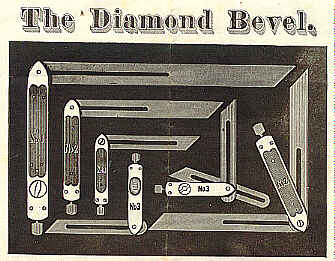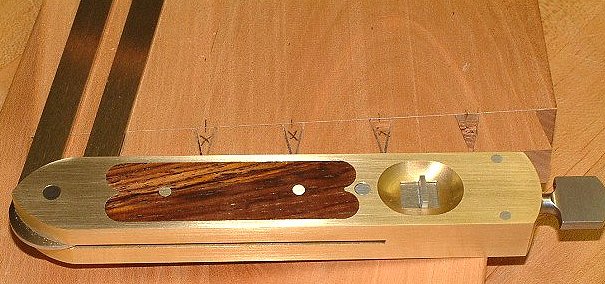

Ever lie awake at night dreaming about the ultimate sliding bevel that also functions as a sliding square? Then read on, as your dream has come true.
Mention the state Vermont to most folks and they'll likely spit back at you skiing, the Green Mountains, and maple syrup. A smaller group of the folks might also mention Calvin Coolidge, Phish, and 60's retro-tie-dye mentality. But, play the same game with a well studied tool-o-phile, and he'll throw E.A.Stearns, Elihu C. Dutcher, and Isaiah J. Robinson in your face faster than you can bisquick a joint. It's this latter fellow, Mr. Robinson, who inspired the reproduction of his fine tool that has no match, for both form and function, on the planet.
Mr. Robinson received the first American patent for a butt locking bevel on June 14, 1870, and being so thrilled with its precious design, promptly named it "The Diamond Bevel." Up until this time, tradesman had to wrestle with flimsy, inefficient, and cumbersome methods of locking a blade firmly to a stock at a pre-determined angle. Seems like a simple objective, right? Well, many tried, but none perfected it until Robinson decided to become bevel-dom's best pal.
Robinson's patent calls for an internal stationary wedge over which a chamfered bar rides, itself activated by a thumbscrew, to place pressure on the blade and keep it stationary. It's a most elegant solution, but manufacturing it proved very costly as precision machining was needed to pull it off. Lucky for us, Robinson pursued his idea, and formed the St. Johnsbury Tool Co. (as a semi-subsidary of the famed scales-maker, E.&T. Fairbanks & Co., of which Robinson was an employee), in St. Johnsbury, VT (of all places), around 1873. It's here that he perfected the design of the tool, elevating it above and beyond a functional tool to a tool that many consider the most stunning bevel ever produced.

In its more graphic form, as it could be had with a polished steel body, the bevel has a gunmetal body with a gothic arch at the pivot point, and a correspondingly radiused curve at its bottom. Between these shapely curves is an inlay of rosewood that gives it a substantial WOW factor along with a warm grip of the tools' appreciable mass. Securing the wood inlay are brass pins that only redlines the tool's curb-appeal to a solid 10. In fact, it can properly be said that these tools are the infills of bevels, and just may show-up your most cherished infill plane. Original examples, when found, are now priced $1,000.00+ (American, not Canadian, dollars) and are generally only available from discriminating tool dealers.
To the left you'll note the original advertising propaganda that St. Johnsbury Tool Co. had printed in 1875. As you can see, the bevel was offered in many different configurations, some with two blades (the angle between the two blades can be used more conveniently than that same angle between just a single blade and the handle). Also, some of the bevels have a cool sliding/twisting tab that converts the bevel to a try square by locking the bevel at 90 degrees to the blade. Ain't it amazing what the engineering mind of 1870's America was busy designing?
Never settling for the same old same old, Superior Works
undertook the
daunting task of making the rarest model of bevel, the one with
the self-squaring
feature to make the tool function as both a sliding bevel and a
sliding
square. Located on one face of the bevel is a milled depression
where access
to a sliding tab can be found. When pushed upward, an internal
mechanism
positions the blade so that it becomes square with the bevel's
sides. No
small chore, a lot of effort went into pulling this off.
Check out these exciting facts....
Yes, a $12.00 plastic bevel will do the same task as a $200+ bevel, but it won't look nearly as nice. This tool isn't for the cheapo's of the world for the same reason an ivory-tipped ebony plough plane wasn't the tool of choice for the average woodworker of yore. You either understand and appreciate fine craftsmanship or you don't. It's often said that fine tools inspire fine workmanship, and with the Studley chest and similar exalted works of the toolmaker's art as proof, who'll be the first to argue against that sentiment?
Sounds too good to be true? Find out just how good and beautiful they are for yourself by pressing on the Ordering link.
[ Home ] | [ Old Tools ] | [ New Tools ] | [ Patrick's B&G ] | [ Ordering]
pal, December 24, 2002